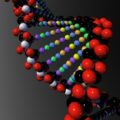
Baby’s first look at the world is likely a dizzying array of shapes and motion that are meaningless to a newborn, but researchers at the University of Rochester have now shown that babies use relationships between objects to build an understanding of the world. By noting how often objects appear together, infants can efficiently take in more knowledge than if they were to simply see the same shapes individually, says the paper published in the current issue of Proceedings of the National Academy of Sciences.
Roughly 100 babies, all about nine months of age, watched a series of shapes such as squares, circles, and arrows appearing together on a screen while researchers watched the babies’ attention. J�zsef Fiser postdoctoral fellow and Richard N. Aslin, professor of brain and cognitive sciences, wanted to see if the nine-month-olds would pay more attention to the pairs of shapes that occurred most often in a crowded scene.
“It’s long been assumed that we use relationships among parts of scenes to learn which parts form whole objects, but the idea has never been tested, nor was it clear how early this ability develops,” says Fiser. “This research shows that building a concept of the world by recognizing relationships among shapes in images is possibly innate, and a very essential ability in babies.”
The next step was to see if nine-month-olds would display this same ability. The babies sat on a parent’s lap in the room while the shapes appeared three at a time on a screen in front of them. After a pause, the shapes appeared again in pairs, and the researchers timed how long the infant stared at each pair. Fiser and Aslin wanted to know if they’d stare longer at the pairs that appeared more often together in the first series, or stare for a shorter time, or whether there was no correlation at all.
When the results of the 72 babies (the rest were dismissed because they wouldn’t cooperate with the pursuit of science) were tallied, a clear correlation emerged. The babies paid more attention when two shapes that had been paired in the first series were shown again together. The infants were using a sort of subconscious statistical analysis of the shapes to pick out those that were familiar, just as the students did.
“In order to make sense of the unknown you must be able to learn new things and represent them to yourself in an efficient way,” says Fiser. “You don’t want a mechanism that will tell you that leaves are always found on cars just because you happened to see a leaf on a car once. You want a mechanism that will tell you that cars can exist without leaves and vice versa, while at the same time telling you that cars always come with wheels, for instance.”
If a baby sees a leaf on a car, she would build a relationship between the two, perhaps calling the combination a “leafcar.” But she might then see several cars without leaves on them and so the concept of leafcar is weakened as she unconsciously realizes that statistically, the concept of leafcar is more and more useless. Noting that every car she sees has wheels, however, becomes statistically more and more useful as it is reinforced with every new car she sees. This relationship-identification is important because the baby can build her knowledge base on it. When she sees a wheelbarrow, she’ll unconsciously note that while all cars have wheels, not all wheels have cars, and a new concept of wheels will begin to emerge. In this way, the frequency of relationships, and the predictability between visual objects allows her to build knowledge on knowledge in a hierarchical manner.
Fiser and Aslin are working on understanding more aspects of what innate ways we have of dealing with the visual world, including studying the very basis of the experiments themselves-why children pay attention at all. Fiser believes that simpler tests essentially bore infants, so the babies pay more attention to new stimuli. In more complex tests, however, it appears that babies tend to focus on those events that are familiar because they are trying to make sense of the scene and are using familiar sights to understand relationships and thus build their knowledge. Fiser hopes to elucidate this distinction further to shed more light on how our brain learns to encode the visual environment around us.


















Comments are closed.